Modern plumbing is becoming more comfortable, technological. A stylish appearance and a high degree of hygiene are mandatory requirements for a toilet. There are many forms of bowls, types of drain, which increase the level of hygiene and facilitate care. The advent of Rimless technology has made it possible to change the toilet system fundamentally. Today there is a choice between tradition and innovation and everyone makes it based on their requirements for plumbing.
Features
Rimless toilets have been developed relatively recently. The authorship of the development belongs to the Japanese brand, whose goal was to create the most hygienic and durable design. Quite quickly, this technology became popular in Europe, a few years ago Rimless systems appeared on the market. Popular are both attached, floor and hanging rimless toilets. Outwardly, the traditional design is no different from the bezelless frame. Outside, they look completely identical.


The changes concern only the internal structure, the bowl, in which there is no traditional rim. Flushing in it occurs completely differently than in the standard rim. In a standard toilet bowl, flushing occurs as follows: water flows around the back of the bowl and washes, heading forward along the rim.
The rim in this case controls the direction of the water; moreover, it does not allow overflowing.

However, with all its perfection, this system has one significant minus - cleaning the area under the rim is extremely difficult. In hard-to-reach places, dirt remains, salts are deposited, smudges appear. Not to mention the fact that this place is considered an accumulation of various bacteria. All this makes the toilet is not too hygienic, in addition, odors appear.

When the rim was removed from the structure, the problem resolved by itself. A smooth bowl is as hygienic as possible, cleaning behind it is not difficult. However, here it is important to clarify all the advantages and disadvantages.
Among the advantage can be identified:
- ease of cleaning, lack of inaccessible areas;
- highest hygiene;
- lower consumption of chemicals;
- aesthetic appearance;
- less water consumption when flushing;
- high sound insulation;
- effective flush.

There are no shortcomings in the conviction of specialists in this system. All conditional negative aspects are associated, rather, with specific models and shortcomings of specific manufacturers. In general, this system has only advantages in comparison with the traditional one. This is especially true for a suspended toilet, because in this design there are no inaccessible zones, not only inside but also outside.

Device and principle of operation
Since the rim is not provided for in the design, the question - why water does not overflow - is natural. After all, it was the rim that kept the water pressure from spraying. In a Romeless design, this function is performed by a ceramic divider, which is located in the flow supply zone. It distributes water in three directions - on the sides and immediately down the bowl.
The cross sections of the device are so precisely calculated that water flows, moving under high pressure, reach the front wall. Flushing is quite effective, removes dirt well.

To prevent water from overflowing, not splashing, companies have developed several containment options:
- stream splitter;
- vortex flow creation;
- special channels and edges.
Varieties
There are a lot of types of rimless structures. In addition to the hanging toilet standard floor and side models. In each of them there are strengths and weaknesses. Floor-standing are considered classics, easier to install, budget-friendly. It is important to consider the size of the bowl and the area of the room. In addition, floor-less rimless models, due to the low tank and poor water supply, may not always provide the ideal flush pressure.

Hanging structures are more convenient. They are hygienic not only inside, but also outside, take up less space, help in creating a stylish interior. Among the minuses, only the cost and complexity of installing the installation can be noted. The tank in this system is built into the wall, it is necessary to consider access to communications at the repair stage. At the same time, the bezel-less hanging toilet is far ahead of the floor in quality. It is less noisy, the water consumption in it is less, in addition, the flows are distributed more competently.
There is a drawback - a small hanging bowl may not be too comfortable, the installation is complicated, the model and installation are expensive.

Attached models have the advantages of both previous designs: they are easy to install, take up little space, are economical, and silent. In addition, they have a deeper bowl.

First of all, wall mounted rimless toilets differ in the way they are mounted to the wall, that is, in the installation:
- blocky - easier and more affordable, but can only be attached to the walls of the bearing type;
- frame - fastens to a wall and a floor, can be applied anywhere;
- angular - To install the toilet in the corner of the bathroom.
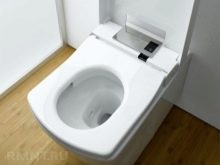


Workmanship is also extremely important. Most often, certain types are used.
- Pottery, i.e. faience and porcelain - the most traditional, they are durable, safe. Porcelain is less porous, easier to care for, but also slightly more expensive than budget faience. In addition, porcelain lasts longer.


- Stainless steel used in most cases for equipping public places. These are very hygienic, durable designs that are easy to care for.

- Glass and plastic. It is rarely used, since the glass is transparent, few people consider this design attractive. Plastic is used mainly in cottages, as it is not too durable.


- Artificial and natural stone also infrequently used, mainly in the design of luxury interiors. Natural stone is durable and hygienic, but expensive, artificial does not have a long service life.
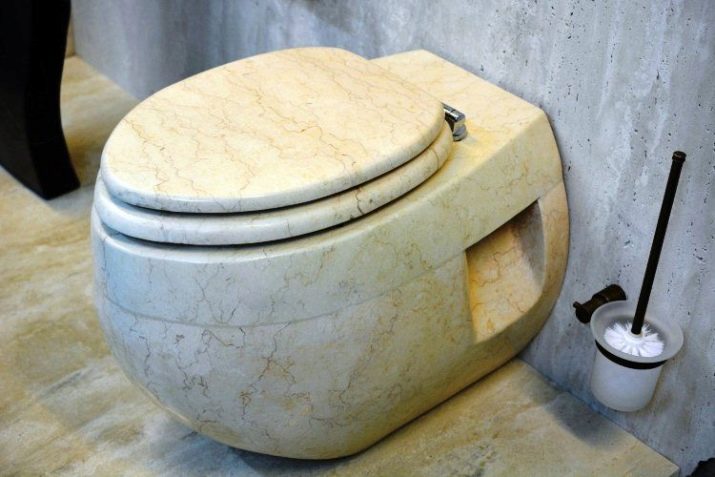
The shape of the bowl of the toilet can be:
- by type of funnel;
- plates;
- visor.
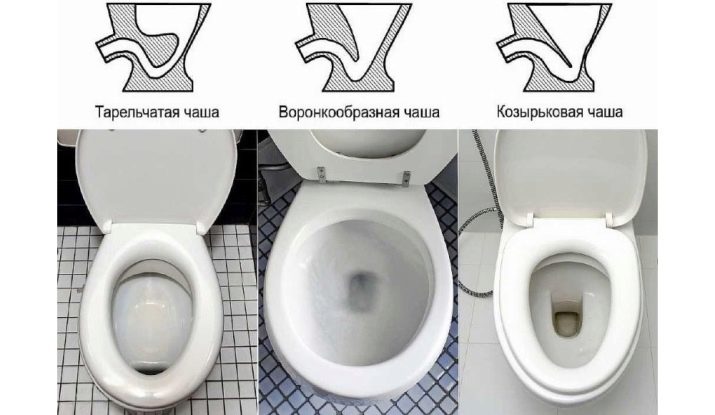
Rimless hanging toilets can have a completely different shape and appearance.
- Circle and oval - traditional forms for plumbing. They are safe, do not have corners, are easy to clean, as they do not have complex elements that make cleaning difficult.

- Square, rectangular - Especially in demand in some stylistic decisions. Well suited for modern interiors. Rectangular is perfect for Japanese-style or high-tech.

- Teardrop - An interesting solution that is suitable for an interior that requires complexity and originality of forms.
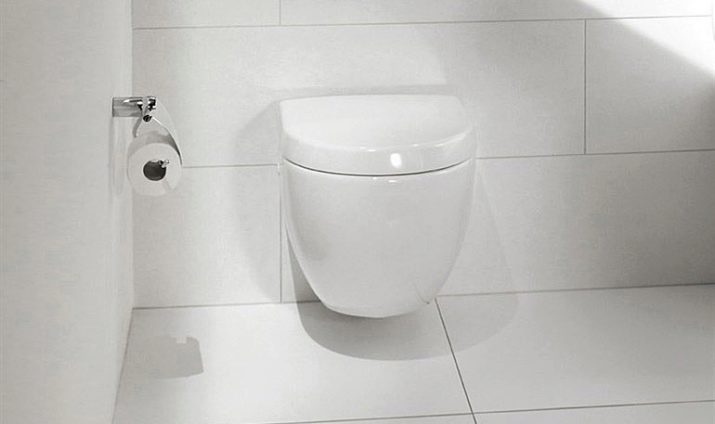
- Ovoid - very popular lately. But he will fit only into the bathroom, where this form will not stand out among others.

It is very important to focus on the overall style and combine the toilet with all the details of the interior.
The smaller the space, the simpler the objects should be.
Wall hung toilets may be shortened, but rimless, as a rule, have standard sizes. In small rooms, the installation of small models is quite acceptable.

Rating of the best models
Firms producing rimless wall-mounted toilets are quite diverse on the market. There is a choice for the most demanding tastes. We offer you a rating of the most popular models from different manufacturers.
Characteristics of Roca The Gap (Spain):
- material - faience, shape - rectangle;
- release into the wall;
- cast flushing divider;
- has an anti-splash system;
- double button, mechanical type.
Pros: economical, beautiful design, hygienic, different types of fasteners, water does not spray, ease of maintenance.
Minuses: earthenware, that is, the service life is not long, the basic configuration requires the purchase of many elements.

Characteristics of Gustavsberg Hygienic Flush WWC (Sweden):
- porcelain, complete with a seat with a micro-lift;
- direct release, there is anti-splash;
- weighs 15 kg;
- frame type installation.
Pros:
- very durable, withstands heavy loads;
- Beautiful design;
- hygienic due to deep flush;
- non-porous coating, repels dirt, does not absorb odor;
- quiet;
- standard mounting type;
- long warranty.
Minuses:
- the lid closes too slowly;
- surface mounting parts make cleaning difficult.

Cersanit Carina New Clean On (Poland):
- shape is a rectangle;
- cover with a micro-lift;
- splash protection;
- dirt-repellent coating;
- installation is purchased separately;
- double type button;
- horizontal release;
- weight - 21.8 kg.
Pros:
- economical water consumption;
- stylish design;
- anti-splash, micro-lift;
- hygienic, practical;
- installation is very simple;
- budget price.
Minuses:
- sometimes the seat is uncomfortable;
- the shape of the bowl may not suit men too much.

Ideal Standart Tesi AquaBlade (Belgium):
- oval-shaped bowl;
- release into the wall;
- anti-splash;
- wash akvableyd completely washes the cup;
- porcelain;
- frame type installation;
- weight - 24 kg.
Pros:
- aesthetic design;
- strong, durable;
- hygienic;
- splash protection;
- long warranty period.
Minuses:
- installation is quite difficult;
- sitting cannot be washed off, the jets are too strong.

Laufen Pro (Switzerland):
- porcelain;
- oval shape;
- horizontal type release;
- anti-splash;
- weight - 21 kg;
- bimodal flushing.
Pros:
- economical, hygienic;
- the flush is very deep and of high quality;
- practical;
- splash protection;
- simplicity in cleaning;
- comfortable fit.
Minuses:
- complex installation;
- incomplete equipment, you need to buy items.
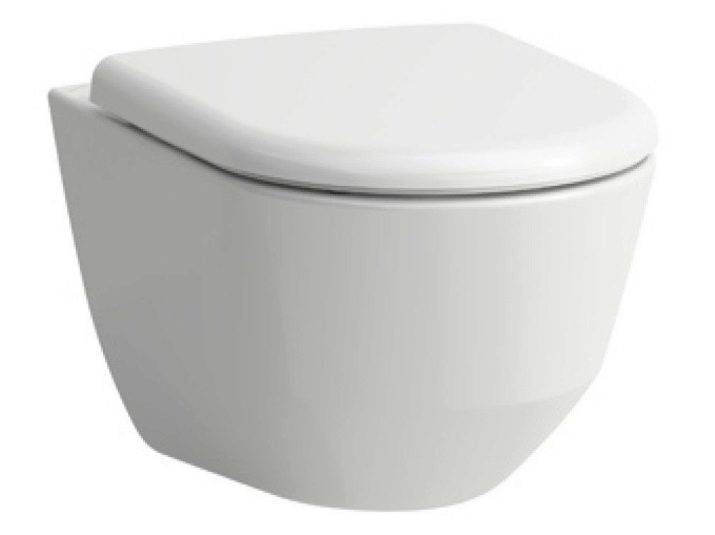
Vitra Zentrum (Turkey):
- porcelain;
- Duroplast seat included;
- direct type release;
- splash protection;
- double type button;
- oval;
- weight - 50 kg.
Pros:
- excellent wear resistance;
- surface repels odor, pollution;
- micro lift;
- silent.
Minuses:
- not everyone will like the design.

How to choose?
When choosing a toilet, it is necessary to rely not only on reviews, but also on the features of the bathroom, its area, type of sewer outlet and other nuances. So that the suspension system does not disappoint, consider the recommendations:
- evaluate the area, the shape and model of the toilet adequate to its size, the method of fastening;
- choose from the rulers only trusted manufacturers;
- in the store, check the operation of all parts, mechanisms;
- Be sure to analyze the configuration;
- Choose models with a smooth surface, especially where the lid is located;
- Do not be afraid to check the toilet in the store, you need to sit on the right model to assess the degree of comfort;
- Duroplast seat is more durable than polypropylene, although more expensive.

Additional functionality provides the greatest ease of use:
- the lid of the toilet bowl with a micro-lift ensures a silent closing; you can not be afraid to sharply release the lid;
- a double button is preferable, as it allows you to dose the water supply;
- model with anti-splash system allows water not to splash;
- the special coating from dirt is less dirty and easier to clean;
- seat heating maintains optimal temperature;
- Bidet provides complete comfort and hygiene;
- drying works on the basis of a hair dryer.
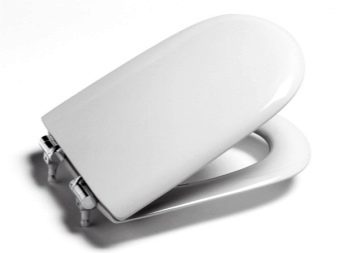



See how to choose a wall-hung toilet in the next video.










